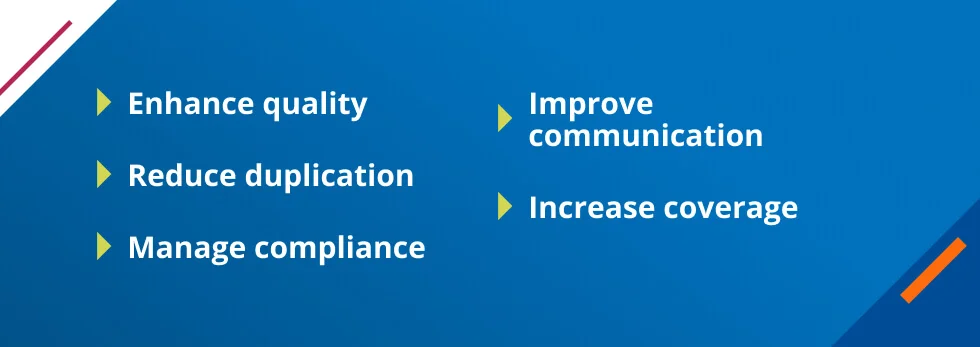
What is a test management tool?
Managing software testing is a highly complex and time-consuming task. Test managers must collect test requirements and design a wide range of tests to evaluate software at various points in the SDLC. Tests must be executed in a timely way and results must be meticulously tracked. Test managers must also communicate with development teams about problems and bugs that are found, prioritizing issues for remediation, and scheduling follow-up tests. Additionally, managers are often asked to provide proof of test results to ensure compliance in regulated industries.
While managing all of these tasks for a single application in development can be complicated, test managers may need to work with hundreds or thousands of application components simultaneously. A test management tool can help by automating much of the process, eliminating human error and minimizing manual effort in the software testing lifecycle. The right tool makes it easier to integrate testing throughout SDLC, ultimately helping to improve the quality of each software release.
Functions of a test management tool
Any test management solution must provide several essential functionalities.
- Capturing requirements. This feature helps QA teams ensure they understand the core functionality of an application and that their tests will cover everything that needs to be tested.
- Planning tests. During the planning phase, QA teams identify the general purpose and structure of testing efforts, including when, where, and how tests should be administered.
- Designing tests. Creating specific tests requires QA teams to define test cases, break them down into detailed steps, and assign manual or automated test scripts.
- Executing tests. The right test management tool should coordinate test resources and ensure that tests are executed properly and in a timely fashion.
- Tracking tests. The right testing platform must track all tests that are executed, logging results and documenting coverage.
- Analyzing results. In addition to keeping track of the outcomes of tests, a testing platform should alert the right people when bugs are found and keep track of efforts to address them.
- Managing users. The testing process may involve a large number of QA testers, developers, and test managers. A superior testing tool can help manage permissions for each user to ensure security.
Benefits of test management tools
The right test management platform will offer significant advantages over manual efforts or test management processes that rely on simple documents and spreadsheets.
- Enhance quality. By improving the efficiency and effectiveness of testing efforts, test management solutions ultimately enable organizations to release better quality software.
- Reduce duplication. Automated test management can help dramatically reduce duplication of efforts in reviewing test requirements, preparing test cases, and addressing defects.
- Manage compliance. In regulated industries, test management tools can help QA teams improve and simplify compliance by tracking details and producing information for audits more easily.
- Improve communication. A test management platform should enable testers and developers throughout the organization to communicate easily, aligning priorities and efforts to seamlessly conduct tests and manage bugs and fixes.
- Increase coverage. By automating tasks and enabling testing teams to manage a greater number of tests more easily, test management tools can help increase coverage to ensure higher quality software.

Important features of a test management tool
The best test management tools include several essential features.
- Ease of use. Superior test management tools must be easy to use, minimizing learning curves and reducing the amount of time required to manage testing activities.
- Scalability. Testing management tools must be able to accommodate testing for hundreds or thousands of applications simultaneously.
- Traceability. Test management technology must trace and track test executions and outcomes, including test runs, issues, bug fixes, and successful tests.
- Organization. One of the most critical capabilities of a test management tool is the ability to assign tasks and track progress across QA and DevOps teams.
- Monitoring. Superior tools should provide visualizations and reports that make it easy for test managers to stay on top of progress in testing and in addressing bugs.
- Flexibility. Any test management solution must be flexible enough to accommodate multiple types of projects and development methodologies.
- Integration. A test management tool must integrate easily with an existing technology stack, especially with the software used to track bugs and issues.
Tricentis qTest: an Agile test management tool
Tricentis qTest is a scalable, enterprise test management solution that integrates seamlessly with DevOps and third-party test tools, offering testing teams a unified view of activities throughout the SDLC. With qTest, QA and development teams can collaborate on a strategic approach to testing and release higher quality software faster.

As a superior test management tool, qTest enables you to:
- Manage testing with centralized control and orchestration of automated workflows, making it easier to embed testing within continuous integration/continuous development pipelines.
- Share and reuse test cases across projects to promote standards, scale best practices, and make it easier to create and maintain test cases.
- Integrate easily with open source and third-party tools, includings native integrations with common test, development and planning solutions like Jira, GitHub, Jenkins, and Selenium.
- Combine solutions for automated, exploratory, and manual testing within a single platform.
- Create shareable, customized reports on testing data, using more than 60 out-of-the-box reports that can be tailored to provide continuous updates.
Along with a test management solution, the Tricentis platform provides a suite of solutions for continuous testing of enterprise applications. From performance testing and app-native testing to chaos engineering, end-to-end testing, and service virtualization, the Tricentis platform can help dramatically accelerate digital transformation, application delivery, and cloud migration.
